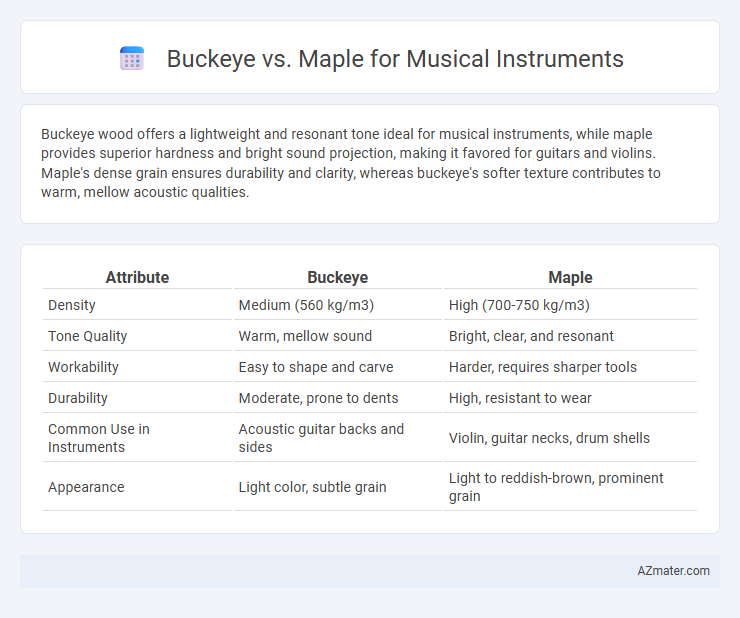Buckeye wood offers a lightweight and resonant tone ideal for musical instruments, while maple provides superior hardness and bright sound projection, making it favored for guitars and violins. Maple's dense grain ensures durability and clarity, whereas buckeye's softer texture contributes to warm, mellow acoustic qualities.
Table of Comparison
| Attribute | Buckeye | Maple |
|---|---|---|
| Density | Medium (560 kg/m3) | High (700-750 kg/m3) |
| Tone Quality | Warm, mellow sound | Bright, clear, and resonant |
| Workability | Easy to shape and carve | Harder, requires sharper tools |
| Durability | Moderate, prone to dents | High, resistant to wear |
| Common Use in Instruments | Acoustic guitar backs and sides | Violin, guitar necks, drum shells |
| Appearance | Light color, subtle grain | Light to reddish-brown, prominent grain |
Introduction to Buckeye and Maple Tonewoods
Buckeye wood is prized in musical instrument making for its lightweight and fine-grain structure, contributing to a warm, balanced tone with moderate sustain. Maple, a classic tonewood, offers bright, articulate sound with excellent clarity and strong projection, often preferred for instruments requiring crisp, vibrant acoustics. Both woods exhibit unique tonal qualities, making them popular choices for guitar backs and sides, with Buckeye delivering subtle warmth and Maple emphasizing brightness and definition.
Physical Characteristics: Buckeye vs Maple
Buckeye wood features a softer, lighter texture with a distinctive pale cream to light brown color, often showcasing irregular grain patterns that provide unique visual appeal in musical instruments. Maple is known for its dense, hard structure and smooth, fine grain, producing a bright, reflective surface with natural light to medium brown hues, often with subtle flame or bird's eye figuring. The physical contrast between Buckeye's softness and Maple's hardness affects tone production, with Buckeye offering warmer, softer tonal qualities and Maple providing clear, bright resonance favored in many string and percussion instruments.
Tonal Qualities: Buckeye Compared to Maple
Buckeye wood produces a warm, mellow tone with moderate sustain, offering unique midrange richness that contrasts with the bright, clear, and articulate sound typical of maple. Maple is known for its strong projection and pronounced high frequencies, making it a popular choice for instruments requiring clarity and brilliance. Musicians seeking a softer, more vintage tonal character often prefer buckeye, while maple remains favored for its consistent brightness and dynamic response.
Workability and Instrument Crafting
Buckeye wood offers moderate workability with a soft, lightweight texture that allows for easy carving and shaping, making it suitable for intricate instrument details. Maple is renowned for its hardness and durability, providing a dense, stable material that enhances tonal clarity and sustain in musical instruments. Crafting with maple often results in instruments with a brighter sound and greater structural integrity, while buckeye allows for more artistic customization but may sacrifice some acoustic performance.
Visual Appearance: Grain Patterns and Colors
Buckeye wood showcases striking, irregular grain patterns with swirling designs and unique burl formations, often featuring a mix of creamy beige, light brown, and occasional dark streaks that create a dramatic, eye-catching effect in musical instruments. Maple, in contrast, offers a more uniform and consistent grain with subtle, wavy flames or birdseye patterns, presenting a classic, elegant appearance with creamy white to light golden hues that highlight the instrument's craftsmanship. These distinct visual characteristics influence the aesthetic choice for luthiers seeking either bold, organic patterns (Buckeye) or refined, traditional looks (Maple) in guitars, violins, and other stringed instruments.
Durability and Stability in Musical Instruments
Buckeye wood offers moderate durability and stability, making it suitable for certain musical instruments but less resistant to wear and environmental changes compared to denser hardwoods. Maple is renowned for its exceptional strength and dimensional stability, providing superior resistance to warping and cracking under varying humidity and temperature conditions. This makes maple the preferred choice for musical instruments requiring long-lasting structural integrity and consistent tonal quality.
Buckeye in Guitar and String Instrument Making
Buckeye wood is prized in guitar and string instrument making for its lightweight yet strong properties, providing excellent resonance and sustain. Its fine grain structure enhances tonal clarity and contributes to a warm, balanced sound often sought by luthiers. Compared to maple, Buckeye offers a unique aesthetic with its distinct yellowish-brown hues and subtle patterning, appealing to craftsmen aiming for both visual appeal and sonic performance.
Maple’s Legacy in Musical Instruments
Maple wood is renowned for its exceptional strength, density, and resonant tonal qualities, making it a preferred choice for high-quality musical instruments such as violins, guitars, and drums. Its tight grain structure contributes to clear, bright sound projection and long-lasting durability, which has established maple as a legacy material among luthiers and instrument makers for centuries. In contrast, buckeye, while workable, lacks the acoustic consistency and historical significance maple holds in the world of precision-crafted musical instruments.
Cost and Availability of Buckeye and Maple
Buckeye wood is less commonly used and therefore generally more expensive than the widely available and moderately priced maple, making maple a cost-effective choice for musical instrument manufacturing. Maple's abundance in North America ensures consistent supply and lower material costs, while buckeye's rarity and limited availability drive up its price. Instruments crafted from buckeye often carry a premium due to the wood's unique tonal qualities combined with its scarce sourcing.
Choosing the Right Wood: Factors for Musicians
Buckeye offers a lightweight, resonant tone with a softer grain, ideal for acoustic instruments requiring warm, mellow sounds. Maple provides a denser, harder surface with bright, clear tonal qualities, often preferred for its durability and strong projection in violins and guitars. Musicians should consider tonal preference, instrument type, and weight when choosing between Buckeye's warmth and Maple's clarity for optimal sound performance.

Infographic: Buckeye vs Maple for Musical Instrument
 azmater.com
azmater.com